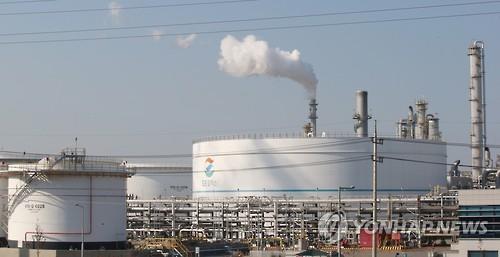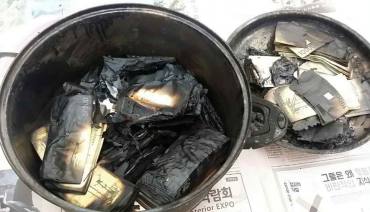
Water vapor billows from a refining facility in an industrial complex in Yeosu, South Korea. (Image : Yonhap)
SEOUL, Feb. 5 (Korea Bizwire) – Despite global oil prices hitting a multi-year low due to a supply glut, local oil refiners pocketed decent earnings last year on the back of improved cracking margins, and their stellar performance may continue into this year, analysts say.
Oil prices have been in the doldrums since early last year on continued concerns over an oversupply. More recently, international sanctions on Iran were lifted allowing the oil-rich country to add new barrels to an already glutted global market.
This year, crude oil prices briefly dropped below the US$30 mark a barrel, hitting an more than 10-year low.
However, the country’s four major oil refiners — SK Innovation Co., GS Caltex Corp., S-Oil Corp. and Hyundai Oilbank Co. — racked up a combined operating income of 4.79 trillion won ($3.99 billion) last year, which presents a four-year high and marks a sharp turnaround from the previous year’s almost 1 trillion won operating loss.
Industry leader SK Innovation logged an operating income of 1.98 trillion won with GS Caltex and S-Oil posting operating incomes of 1.3 trillion won and 878 billion won each.
“Recent slides in oil prices are caused by increased stockpiles, not by reduced demand,” said Yoon Jae-sung, an analyst at Hana Investment & Securities. “Local refiners are enjoying higher cracking margins on the back of low prices and firm demand.”
In 2014, major South Korean oil refiners posted their worst-ever performance as a freefall in oil prices hurt the value of their crude inventories amid tight cracking margins.’
SK Innovation and No. 3 S-Oil both posted operating losses in 2014, going into the red for the first time in more than three decades. No. 2 refiner GS Caltex said it also logged an operating loss of 456.3 billion won last year, its first in six years.
Their dramatic rebound was aided by improving refining margins. About 58 percent of their earnings came from the oil-refining business last year.
The refining margin stood between $7 and $8 per barrel last year, far higher than the average $5 posted in 2014, which led to massive losses for local refiners.
Usually, a refiner can generate a profit with a refining margin of $4 or more per barrel.
This year’s refining margin is estimated at $9.90 per barrel, and the comparable figure would be $10.50, according to Lee Do-yeon, an analyst at Korea Investment & Securities.
Analysts said cheap crude oil is helping improving bottom lines. About 85 percent of oil imports come from the Middle East. The price of Dubai crude, South Korea’s benchmark, stayed below $30 per barrel, the lowest since 2003.
In 2014, Dubai crude hovered around $100 per barrel, but continued to slide because of the supply glut.
Moves to diversify supply chains and beef up facilities that produce high-end products also helped improve earnings, industry watchers said.
“Oil prices could face increased volatility down the road, but we have to pay attention to this trend (rising cracking margin and firm demand,” said Lee.
Analysts said that refining margins will soften modestly this year compared to the levels registered in 2015, but remain meaningfully higher than the levels seen in 2013 and 2014, and sizable inventory losses in 2015 are unlikely to repeat this year.
Lee Jin-yeon, an analyst at IBK Investment & Securities, said inventory losses will be further curbed down the road despite lower oil prices.
“What’s more important is that their cracking margin will remain solid,” the analyst said.
(Yonhap)






